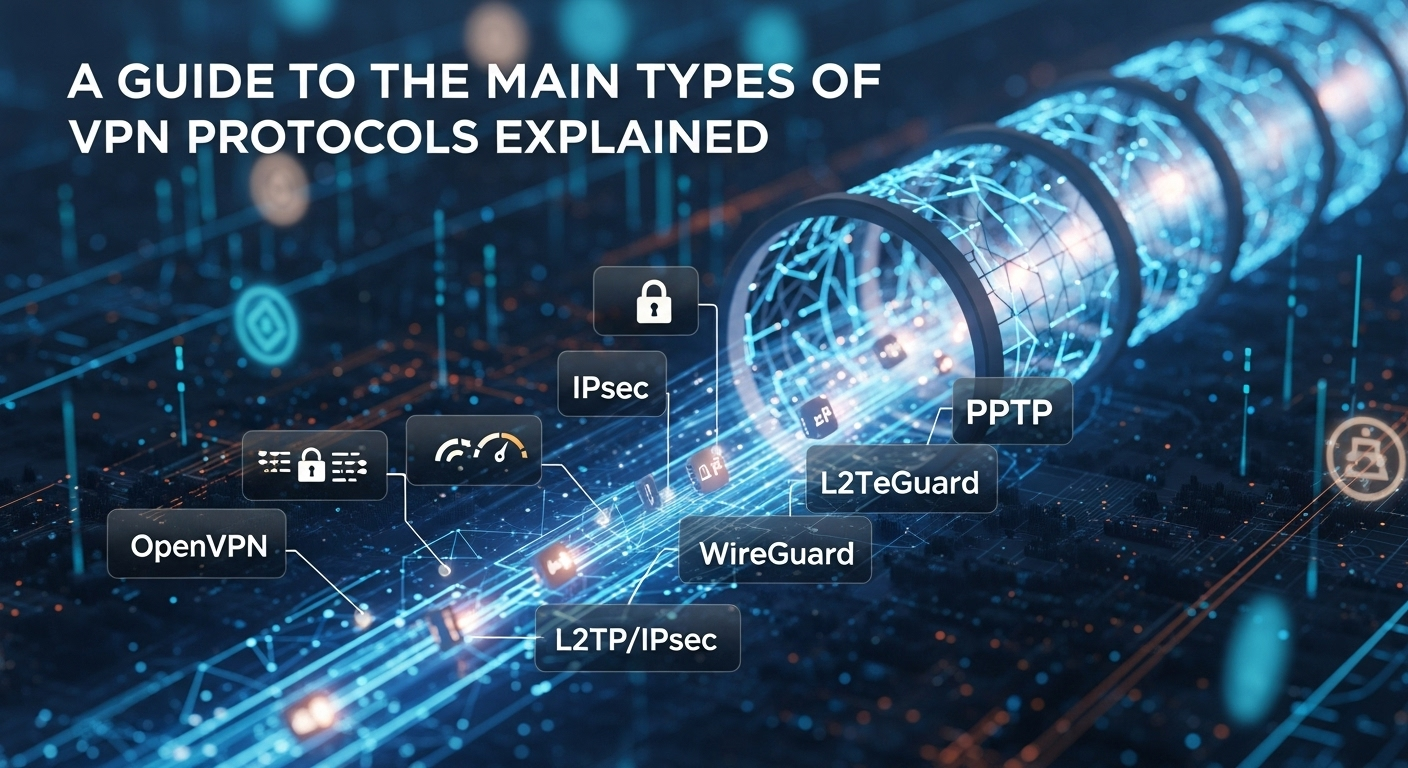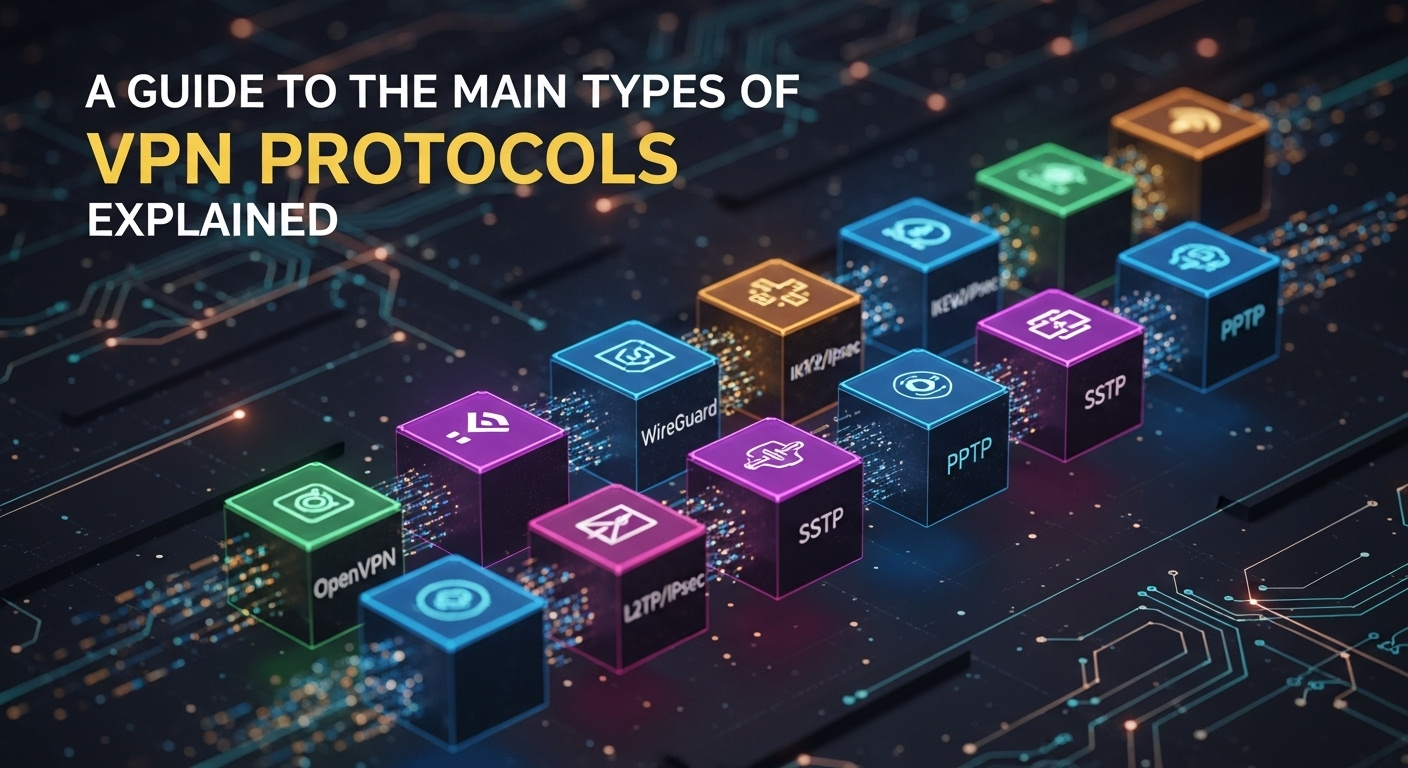Navigating the world of online privacy can feel like learning a new language, filled with acronyms and technical jargon. At the heart of every Virtual Private Network (VPN) service lies a critical component that determines its speed, security, and reliability: the VPN protocol. Think of a protocol as the engine of your VPN; it's the set of rules that dictates how your data is encrypted and routed from your device to the VPN server. Understanding the fundamental differences between them is key to choosing a service that truly meets your needs, whether you're a privacy advocate, a streaming enthusiast, or a remote worker. This comprehensive guide provides a deep dive into the main types of vpn protocols explained, breaking down their strengths, weaknesses, and ideal use cases to empower you to take control of your digital security.
Table of Contents
ToggleWhat Are VPN Protocols and Why Do They Matter?
Before we dissect the individual protocols, it's crucial to understand their role in the VPN ecosystem. A VPN protocol is essentially a set of instructions that governs the creation and maintenance of the secure connection, or "tunnel," between your device and the VPN server. It defines how authentication happens (proving you are who you say you are), how the encryption is applied (scrambling your data), and how the data is packaged and transported through the internet. Without a protocol, a VPN is just a network of servers with no secure way to connect to them.
The choice of protocol has a direct and significant impact on your user experience. It's a constant balancing act between three core pillars: speed, security, and stability. Some protocols are built like a fortress, using incredibly strong encryption that might slightly slow down your connection. Others are designed to be lightweight and fast, perfect for streaming or gaming but perhaps not the best choice for handling highly sensitive financial data. The right protocol for you depends entirely on what you prioritize.
Ultimately, understanding VPN protocols matters because it allows you to move beyond marketing claims and make an informed decision. A VPN provider might boast about its massive server network, but if it only offers an outdated and insecure protocol, that network is built on a weak foundation. By learning the difference between a protocol like WireGuard and an obsolete one like PPTP, you can properly evaluate a VPN service's security posture and ensure you're getting the protection you're paying for.
The Modern Champions: OpenVPN and WireGuard
In the contemporary VPN landscape, two protocols stand head and shoulders above the rest: OpenVPN and WireGuard. They represent the current pinnacle of VPN technology, each with a passionate following and distinct advantages. Most top-tier VPN providers offer both, allowing users to switch between them based on their immediate needs. These two are often the default recommendation for the vast majority of users due to their excellent blend of modern security and performance.
OpenVPN has long been the undisputed king, a battle-hardened veteran known for its unwavering security and reliability. For over two decades, it has served as the industry's gold standard. WireGuard, on the other hand, is the lean and fast-moving challenger. It’s a relatively new protocol that has taken the industry by storm with its groundbreaking speed and elegant simplicity, quickly becoming a favorite for performance-critical tasks.
Choosing between them is not about picking a "winner" but understanding their design philosophies. OpenVPN is about maximum security and configurability, while WireGuard is about maximum speed and simplicity. We will explore each in detail to help you understand which modern champion is the right fit for your digital life.
OpenVPN: The Gold Standard of Security
First released in 2001, OpenVPN is an open-source protocol that has become the benchmark against which all other protocols are measured. Its "open-source" nature is a significant advantage; it means its source code is publicly available for anyone to inspect for vulnerabilities. This transparency has led to a global community of security experts constantly auditing and strengthening the code, making it incredibly trustworthy and secure. OpenVPN uses the robust OpenSSL library for encryption and can be configured to use a wide variety of encryption ciphers, including the industry-standard AES-256.
The protocol's greatest strengths are its immense flexibility and security. It can run over two different transport protocols: TCP (Transmission Control Protocol) and UDP (User Datagram Protocol).
- OpenVPN UDP: This is the default and preferred option. It's faster because it doesn't require acknowledgment for every packet sent, making it ideal for streaming, gaming, and general browsing.
- OpenVPN TCP: This option is slightly slower but more reliable. It ensures every packet is received in the correct order, and it can be configured to run on port 443, the same port used for standard HTTPS traffic. This makes it exceptionally good at bypassing restrictive firewalls in countries or on networks that block VPNs.
Its main drawbacks are its relatively heavy code base, which can result in slightly slower speeds compared to newer protocols, and the complexity of a manual setup, although this is a non-issue when using a commercial VPN provider's app.
WireGuard: The Lean, Mean, Speed Machine
WireGuard is the exciting newcomer that has fundamentally changed the VPN protocol conversation. Designed from the ground up to be a simpler, faster, and more secure alternative to older protocols like IPsec and OpenVPN, its defining feature is its streamlined codebase. While OpenVPN has hundreds of thousands of lines of code, WireGuard has only about 4,000 lines. This extreme simplicity makes it far easier for security researchers to audit, dramatically reducing the potential for hidden vulnerabilities.
The primary advantage of WireGuard is its blazing-fast speed and near-instantaneous connection times. It uses state-of-the-art cryptography, such as the ChaCha20 cipher, which is less computationally intensive than AES, allowing for faster throughput and better battery life on mobile devices. This performance boost makes it the undisputed champion for activities like 4K streaming, online gaming, and large file downloads. Its lean design also contributes to greater stability, especially on mobile networks.
However, WireGuard is not without its considerations. By default, it stores user IP addresses on the server until the server is rebooted, which presents a potential privacy concern. Reputable VPN providers have addressed this by implementing their own solutions, such as using a double NAT system to assign a dynamic IP to every connection without storing any personally identifiable information. While it is now integrated into the Linux kernel—a massive vote of confidence—it is still a newer technology than the venerable OpenVPN.
The Reliable Workhorses: IKEv2/IPsec and L2TP/IPsec
While OpenVPN and WireGuard dominate the headlines, there are other established protocols that remain highly relevant and useful, particularly in specific contexts. Protocols like IKEv2/IPsec and L2TP/IPsec are often natively integrated into operating systems like Windows, macOS, and iOS, making them convenient options for manual configurations. They are often perceived as a "combo" protocol, where one part handles the tunnel (L2TP, IKEv2) and the other handles the security (IPsec).
These protocols are the reliable workhorses of the VPN world. They may not have the cutting-edge speed of WireGuard or the open-source pedigree of OpenVPN, but they offer solid security and excellent stability, making them a fallback or even a primary choice for certain users. IKEv2/IPsec, in particular, has carved out a powerful niche for mobile users who are constantly on the move.
Understanding these protocols is important because they are widely supported and often appear as an option in your VPN client's settings menu. Knowing when to use IKEv2/IPsec over, say, OpenVPN can significantly improve your connection's stability and performance, especially when you're away from your home or office network.
IKEv2/IPsec: The Mobile User's Best Friend
IKEv2 stands for Internet Key Exchange version 2, and it is a tunneling protocol that is almost always paired with IPsec (Internet Protocol Security) for encryption and authentication. Co-developed by Microsoft and Cisco, IKEv2/IPsec is known for its exceptional stability. Its most lauded feature is its support for the Mobility and Multihoming Protocol (MOBIKE), which allows it to maintain a stable VPN connection even as you switch between networks.
This makes IKEv2/IPsec the undisputed champion for mobile users. If you're walking down the street and your phone switches from your office Wi-Fi to a 5G cellular network, an IKEv2/IPsec connection will remain stable and re-establish itself almost instantly without you noticing. This is a huge advantage over other protocols that might drop the connection and require a manual reconnect. It's also quite fast, often outperforming OpenVPN in speed tests.
The downside to IKEv2/IPsec is that it's not as universally compatible with firewall-bypassing techniques as OpenVPN. Since it uses UDP port 500, it can be more easily blocked by network administrators or in regions with heavy internet censorship. Furthermore, while its security is considered very strong, its closed-source development by large corporations makes some privacy purists slightly more wary compared to open-source alternatives.
L2TP/IPsec: A Solid but Slower Alternative
L2TP, or Layer 2 Tunneling Protocol, is another protocol that, like IKEv2, does not provide any encryption on its own. For this reason, it is almost exclusively implemented with the IPsec suite to secure the data. This combination, L2TP/IPsec, was once a very popular and secure option, seen as a major upgrade over the older and insecure PPTP protocol. It's natively supported on a vast range of devices and operating systems, which makes it a convenient choice if your device doesn't support more modern protocols.
The main strength of L2TP/IPsec is its wide availability and proven security (thanks to IPsec). It provides a reliable and safe connection that is sufficient for general browsing and security on public Wi-Fi. However, its primary weakness is its performance. The protocol works by "double-encapsulating" your data—first by L2TP and then again by IPsec. This process adds significant computational overhead, making it noticeably slower than OpenVPN, IKEv2, and especially WireGuard.
Additionally, just like IKEv2/IPsec, L2TP/IPsec often struggles with restrictive firewalls. It uses a fixed set of ports that can be easily identified and blocked. While it's still a secure option, its lack of speed and flexibility has led most VPN providers and users to favor more modern and efficient protocols. It's best seen as a legacy option or a fallback if other protocols are unavailable.
The Legacy Protocols: PPTP and SSTP

As technology evolves, some protocols are left behind, either replaced by superior alternatives or retired due to critical security flaws. In the world of VPNs, this category is primarily occupied by PPTP and, to a lesser extent, SSTP. These protocols represent an older era of VPN technology. One is dangerously insecure and should be avoided at all costs, while the other serves a very narrow, platform-specific purpose.
It is critically important for users to recognize these legacy protocols and understand why they are generally not recommended. A VPN service that still prominently features or defaults to PPTP is a major red flag, indicating that the provider may not be prioritizing user security. While SSTP has its uses, its proprietary nature and platform dependency limit its appeal in a world dominated by open-source and cross-platform solutions.
Think of these protocols as relics in a museum of technology. While they were important in their time and paved the way for what came next, you wouldn't rely on them for your security in the modern digital age.
PPTP (Point-to-Point Tunneling Protocol): Fast but Fatally Flawed
PPTP is one of the oldest VPN protocols, developed back in the 1990s by a consortium including Microsoft. For a long time, it was the standard for remote-access networks due to its high speeds and native integration into Windows. Its speed comes from its very weak encryption standards. In the early days of the internet, this was an acceptable trade-off for many.
However, in the modern era, PPTP is considered completely obsolete and dangerously insecure. Its underlying authentication protocols (MS-CHAP-v1 and v2) have been thoroughly compromised for years. It is widely known that government agencies like the NSA can crack PPTP encryption with relative ease. You should never use PPTP for any task that requires privacy or security. Its presence is a warning sign, and it should only be considered for geo-unblocking content where security is absolutely not a concern—and even then, better options exist.
SSTP (Secure Socket Tunneling Protocol): Microsoft's Proprietary Solution
SSTP is a proprietary VPN protocol owned and developed by Microsoft, introduced with Windows Vista. Its key feature and main advantage is its ability to use SSL/TLS for encryption over TCP port 443. This is the same port and encryption method used by all HTTPS websites (the "s" in "https" stands for secure). Because SSTP traffic looks identical to regular, secure web traffic, it is extremely effective at bypassing even the most stringent firewalls.
This makes SSTP a very reliable choice for users in countries with heavy internet censorship or on restrictive corporate or school networks that block other VPN protocols. It's quite secure, and since it's integrated into Windows, it's easy to set up and use for Windows users. The major drawback, however, is its proprietary, closed-source nature. The code cannot be independently audited by the security community, so you must place your full trust in Microsoft's implementation. Furthermore, its support on other platforms like macOS, iOS, and Linux is limited or non-existent, making it a niche, Windows-centric solution.
How to Choose the Right VPN Protocol for You
With a clear understanding of the major protocols, the final step is to apply this knowledge to your own use case. The "best" VPN protocol is not a one-size-fits-all answer; it's a personal choice based on your priorities. You should consider what you'll be doing most often while connected to the VPN. Are you mainly concerned with protecting your banking information on public Wi-Fi? Or are you trying to stream a 4K movie from a server halfway across the world?
For most users in 2024 and beyond, the choice will boil down to WireGuard vs. OpenVPN.
- For maximum speed: Choose WireGuard. It is the ideal protocol for streaming, gaming, torrenting, and any activity where performance is paramount.
- For maximum security and reliability: Choose OpenVPN. Its battle-tested, open-source code and ability to bypass firewalls with OpenVPN TCP make it the top choice for journalists, activists, or anyone handling highly sensitive information.
- For mobile stability: Choose IKEv2/IPsec. Its ability to seamlessly switch between networks makes it the perfect "set it and forget it" option for your smartphone.
Fortunately, you rarely have to make a permanent choice. The vast majority of premium VPN applications allow you to easily switch between protocols in their settings menu. Many even have an "Automatic" or "Recommended" setting that will choose the best protocol for your current network conditions. To simplify your decision, refer to the comparison table below.
VPN Protocol Comparison Table
| Protocol | Speed | Security | Stability | Firewall Bypass | Best Use Case |
|---|---|---|---|---|---|
| WireGuard | Excellent | Very High | High | Good | Streaming, Gaming, General Use |
| OpenVPN | Good | Excellent | High | Excellent (TCP) | High-Security Needs, Bypassing Censorship |
| IKEv2/IPsec | Very Good | High | Excellent | Moderate | Mobile Devices, Network Switching |
| L2TP/IPsec | Fair | Good | Good | Poor | Legacy Devices, Fallback Option |
| SSTP | Good | Good | High | Excellent | Windows Users Bypassing Firewalls |
| PPTP | Excellent | Very Low | Fair | Poor | (AVOID) Not Recommended |
Frequently Asked Questions (FAQ)
Q: Which VPN protocol is the best overall?
A: There is no single "best" protocol for everyone, as the ideal choice depends on your specific needs. However, for most users today, the top two contenders are WireGuard (for its superior speed and modern design) and OpenVPN (for its proven security, reliability, and ability to bypass firewalls). Most reputable VPNs recommend using one of these two.
Q: Can I easily switch between VPN protocols?
A: Yes. Almost all modern, user-friendly VPN applications have a settings menu where you can select your preferred protocol from a dropdown list. This allows you to switch from WireGuard to OpenVPN in seconds if you find one works better on a particular network. Many apps also offer an "Automatic" setting that intelligently selects the best protocol for you.
Q: Is WireGuard better than OpenVPN?
A: "Better" is subjective. WireGuard is significantly faster, more lightweight, and uses more modern cryptography, making it superior for performance-based tasks like streaming and gaming. OpenVPN, on the other hand, has been audited and battle-tested for over two decades, is more configurable, and its TCP mode is more effective at bypassing restrictive firewalls. For pure speed, WireGuard wins. For proven, auditable security and versatility, OpenVPN still holds a strong position.
Q: What is the most secure VPN protocol?
A: OpenVPN is widely regarded as the gold standard for security. Its open-source nature means its code has been scrutinized by countless security experts over many years. Its high configurability, including the ability to use AES-256 encryption, makes it exceptionally secure. While WireGuard's modern cryptography is also extremely secure, OpenVPN's long and transparent track record gives it the edge in trustworthiness for the most security-conscious users.
Q: Why should I absolutely avoid the PPTP protocol?
A: You should avoid PPTP because it has severe, well-known, and unfixable security vulnerabilities. The protocol's encryption has been effectively broken, meaning that a moderately skilled attacker, and certainly government agencies, can intercept and decrypt your traffic. Using PPTP is like locking your front door with a lock that everyone has the key to. For any activity where privacy or security matters, PPTP offers a false sense of security and should never be used.
Conclusion
Understanding the types of VPN protocols is no longer a topic reserved for cybersecurity experts; it's essential knowledge for any conscious digital citizen. The protocol is the technological heart of your VPN, directly influencing its performance, security, and stability. By moving past the marketing jargon and grasping the core differences between these protocols, you can make smarter choices about the services you use and how you use them.
For the vast majority of your online activities, the modern duo of WireGuard and OpenVPN will serve you exceptionally well, offering a powerful combination of top-tier speed and fortress-like security. IKEv2/IPsec remains a fantastic choice for mobile stability, while older protocols like L2TP/IPsec serve as decent fallbacks. The key takeaway is to always avoid the fatally flawed PPTP. Armed with this knowledge, you are now better equipped to tailor your VPN experience to your needs, ensuring you have the right tool for the job and taking a significant step toward true online privacy and freedom.
***
Article Summary
This guide provides a comprehensive explanation of the main types of VPN protocols, the core technologies that determine a VPN's speed, security, and stability. It begins by defining what a VPN protocol is and why understanding the differences between them is crucial for users. The article then dives into detailed sections on the most important protocols.
First, it covers the "Modern Champions," OpenVPN and WireGuard. OpenVPN is presented as the industry's gold standard for security, known for its open-source code and reliability, while WireGuard is highlighted as the fast, modern challenger praised for its incredible speeds and streamlined design. Next, it explores the "Reliable Workhorses," IKEv2/IPsec and L2TP/IPsec. IKEv2/IPsec is identified as the best choice for mobile users due to its connection stability, whereas L2TP/IPsec is described as a slower but widely available legacy option.
The guide also warns against "Legacy Protocols," specifically the dangerously insecure PPTP, which should be avoided at all costs, and the proprietary, Windows-centric SSTP, which is useful for bypassing firewalls. A comparative table summarizes the key features of each protocol, and an FAQ section answers common user questions. The conclusion reinforces that for most users, WireGuard and OpenVPN are the top choices, empowering readers to select the right protocol based on their specific needs for speed, security, or stability.
















